Classification of Engines
Broadly speaking, an engine is a
device that converts energy into useful mechanical power. The term
"engine" usually refers to heat engines -- engines that convert heat energy to
mechanical energy. Heat engines usually consume fuel to produce the
heat.
Heat engines are divided into two
categories -- internal combustion (burning) and external combustion. A
conventional gasoline engine is an internal combustion engine; gasoline is
burned inside the cylinders to produce hot gases whose expansion moves the
pistons. Steam engines are external combustion engines; fuel is burned outside
the engine itself, producing high temperature, high pressure steam which them moves pistons or a rotating turbine.
When steam is formed from water, it requires about 1600
times as much volume as the water from which it is formed. The force produced by
this expansion is the source of power in all steam engines. In a confined space,
such as a cylinder, the force is manifested as pressure that forces a piston
back and forth in the cylinder, as steam enters from alternate ends of the
cylinder. The steam is routed to the appropriate end of the cylinder by valves
actuated by the motion of the piston. In a true steam engine, work is done by
steam pressure, rather than by condensation. The expansion from a liquid
to a gas produces the pressure which pushes the pistons along inside the
cylinders of a steam engine.
By the end of the nineteenth century, many different models of steam
engines had been invented, so many in fact, that by 1908, even traditional
Oxford was accepting mechanical science as a suitable subject for undergraduates.
There was much to learn, as steam engines were everywhere.
The diverse models of steam engines can be divided into
three general types: Stationary (factory),locomotive (trains, cars) and marine
(ships. Each of these three major types is further classified as to the axis of
the piston shaft or turbine cylinder (vertical, inclined or horizontal), by the
type of valve gear ("D", piston, poppet or rotary), and by the number of
cylinders (or turbine stages) used for expanding the steam (single, double, triple or quadruple expansion).
Stationary engines were produced with vertical, horizontal
or inclined cylinders. Railway locomotives generally had horizontal cylinders,
although a few specialized types were produced with vertical or inclined
cylinders. Ships started off with horizontal cylinders driving paddle wheels,
but quickly changed to vertical cylinders and pistons driving screw propellers through a
crankshaft.
Early engines used the "D" shaped slide valve, but as machining skills
were improved, these were replaced by poppet, piston or rotary valves.
Nearly all locomotives built after 1930 used piston valves. Most large stationary
engines used rotary valves, which were greatly improved by the addition of the
Corliss "drop cut-off" gear.
Because steam required about 1,600 times the space as the
water from which it was formed, the pressure in a single cylinder engine at the
time the exhaust valve opened could still be quite high. In order to gain
efficiency, many engines were built with multiple cylinders that allowed the
exhaust from the preceding cylinder to be expanded again in a larger secondary,
tertiary or quaternary cylinder, again driving a piston. In ships and
factories, double and triple expansion engines were common, as their additional
size and weight were compensated by added efficiency and lower fuel consumption. Railroads tried double expansion
locomotives, but quickly found that lower weight and size were more significant
benefits than fuel economy.
Steam and Safety
The safety--or lack of
safety--of steam was an important part of its history. The boilers which
contained the steam were prone to explode. This occurred for a variety of reasons:
undetected corrosion or furring of the heated surfaces, clumsy repairs, or
failure to keep the water up to the required level, so causing firebox plates to
overheat. As early as 1803 a safety device, a lead plug, was invented. The
plug was designed to melt if the firebox crown became overheated and release
steam before worse damage was done. However, this device was not adopted widely.
After an 1854 explosion in England that killed ten people, the Boiler
Insurance and Steam Power Company was started. Not until 1882, though, was safety
legislation introduced in Britain. In the United States there was no government regulation at
all.
Following the enaction of safety legislation in England, the number of
lives lost in England from boiler accidents fell from 35 in 1883 to 24 in 1900
and to 14 in 1905. During a comparable time period in the United States, 383
people were killed in boiler accidents. The problem of safety with steam engines
was eventually reduced by the introduction of new forms of power, including the
steam turbine. However, boiler accidents remain a fact of life even today, and
continue to cause fatalities.
Another danger associated with steam locomotives was fires caused by the
embers from the smokestacks. Since British trains used coke (a by-product of
coal that burns without creating a large number of flying embers) as fuel, their
builders did not have to worry about the trains igniting the passengers, the
coaches and the surrounding countryside. American railways, however had
adopted the cheapest (at that time) native fuel, wood, and had to deal with the
embers and live sparks escaping from train smokestacks.
In one incident in 1832, a New England railroad car was set
on fire by a locomotive spark , burning $60,000 in paper money. One angry
passenger protested that not a single person traveling by train in the United
States, "has not been annoyed, and either had his flesh or clothing
burnt". The spark problem was so apparent that over 1,000 patents were
issued for smokestacks and spark arresters during the nineteenth century. Two
conflicting conditions prevented the development of a practical design. An
unobstructed draft was necessary for good steaming: an effective spark arrester
necessarily obstructed the draft. Obviously a compromise was necessary.
The answer lay in the bonnet stack: It was by far the most common type of
wood-burning engine smokestack. Usually identified by its distinctive funnel
shape, it is named for the bonnet-shaped wire screen or netting arched over
its top. The funnel-shaped outer casing, more than 5 feet in diameter at the top,
is a hopper for holding cinders. The bonnet stack, invented In 1831, became one
of the mast distinctive features of the nineteenth century American locomotive.
By the early 1890s, the bonnet stack and other similar ones were abandoned for
inside smoke box designs.
History of Steam Engines: An Overview
 Hero was not the only ancient
familiar with the concept of steam power. Records of a simple hot air engine,
designed to open and close temple doors, are among records from ancient Egypt dating to
280 B.C.
Hero was not the only ancient
familiar with the concept of steam power. Records of a simple hot air engine,
designed to open and close temple doors, are among records from ancient Egypt dating to
280 B.C.
A church existed in France that was equipped with an organ blown by
air escaping from a vessel in which it was compressed "by
heated water". The date -- 1125 A.D.
In 1543 (only a few years
after Columbus' initial voyage to the western hemisphere), Spanish naval officer
Blasco de Garay attempted to move a paddle-wheeled ship powered by a steam
engine. De Garay should probably get the credit for being the first to
appreciate the use of steam for marine propulsion.
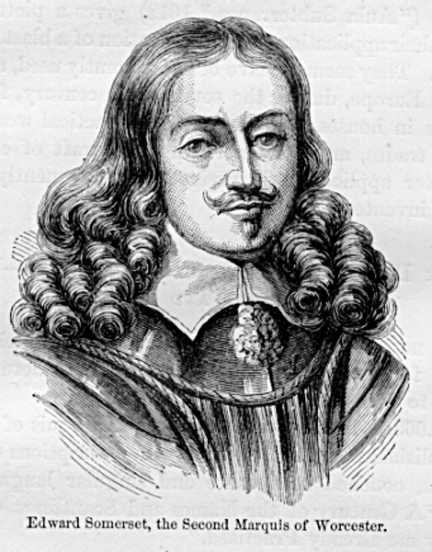 Edward Somerset, second Marquis of Worcester, England, is
credited with being the first operating steam engine builder. In 1663, he
invented an apparatus for raising water by steam power, and it was actually used
for this purpose at Vauxhall, near London.
Edward Somerset, second Marquis of Worcester, England, is
credited with being the first operating steam engine builder. In 1663, he
invented an apparatus for raising water by steam power, and it was actually used
for this purpose at Vauxhall, near London.
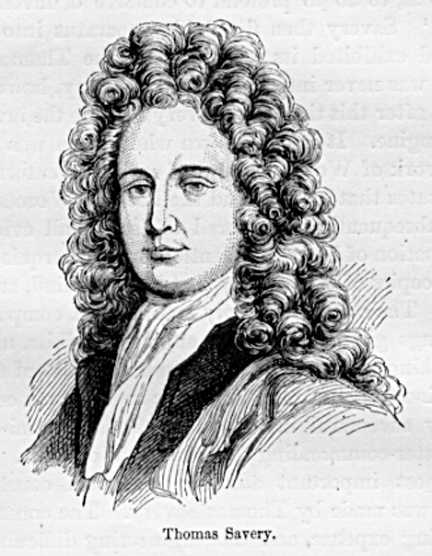 In 1698 Captain Thomas Savery
(1650-1715), also of England, became the first person to produce and sell a
workable steam pump for raising water. It was crude, relying on hand
operated steam and water valves. Because the maximum suction lift of the pump
was only 25 feet, the receiver and furnace had to be located
underground.
In 1698 Captain Thomas Savery
(1650-1715), also of England, became the first person to produce and sell a
workable steam pump for raising water. It was crude, relying on hand
operated steam and water valves. Because the maximum suction lift of the pump
was only 25 feet, the receiver and furnace had to be located
underground.
Steam Power and the Industrial Revolution
Between 1780 and 1830, in less than the space of three
generations, the industrial world changed irrevocably. The world became a place
where humans handled great amounts of energy to an extent inconceivable in the
preceding agrarian age. The defining feature of the Industrial Revolution
was a dramatic increase in per capita production, made possible by the more
efficient manufacturing processes of the new, steam driven factories.
The relentless force of steam,
expanding out of boilers, powered the Industrial Revolution. It replaced the
fatigue-ridden muscle power of humans and animals and allowed people to do
things that muscle power alone could not do. Before the 1700s, most
factories depended on wind or water for power. Steam power inspired invention in
many areas; ships, railroads, mills and mines, to name a few. Steam became so
widely used that the period of the Industrial Revolution is also called "The Age
of Steam". Though steam engines have passed the prime of their usefulness, their
legacy remains, for they first put into human society the fantastic and fruitful
notion of using heat to produce mechanical movement. It is this idea, more than
any other, that has shaped our whole technical civilization. While it is
difficult to specify the exact time and place the Industrial Revolution started,
by by 1760 all the scientific and technological developments were in place to
make the Industrial Revolution inevitable.
The Industrial Revolution started in England, and at its
root was coal, which England had in abundance. Wood had been England's primary
fuel, but the forests were being burned faster then they could be replaced. As a
result, people turned to coal, but coal was not easy to mine. It was often found
deep in the earth, frequently under water. Steam became the source of power to
pump out the water and to lift to the surface the fuel the engines burned.
The Industrial Revolution had major social impact: It changed agrarian
societies to industrial societies. Populations migrated from farms to
cities as cities became places of opportunity and personal development in ways
that had never been possible in the closed, static rural society. However,
industrial work was often more tedious, unhealthy and dangerous than work in
agriculture or domestic industries. Women and children were exploited
until the introduction of protective labor laws in the twentieth century. The
skills of many workers were made obsolete, and nearly all workers became
dependent upon market forces far beyond their control. The machines seemed to
become their masters. Eventually, workers found strength through common
experience, developing labor unions and political organizations to correct the
worst excesses and protect their interests.
In the long run, the Industrial Revolution has benefited most nations by
providing an escape from the poverty trap; the cycle of low income, low
consumption, low demand and low production. In some areas of the world, the
process can be observed to this day. Despite the resistance of the warlords,
monks, and autocrats being displaced by skilled professionals and merchants, the
process of industrialization yields a new, large middle class endowed with a
high degree of literacy, economic power, political influence and capital -- and
willing to endorse quantitative measurement and experimentation.
A question to consider: Are there parallels between the
role of steam in the Industrial Revolution and the role of the computer at the
close of the twentieth century?
Dennis Papin's Piston Engine
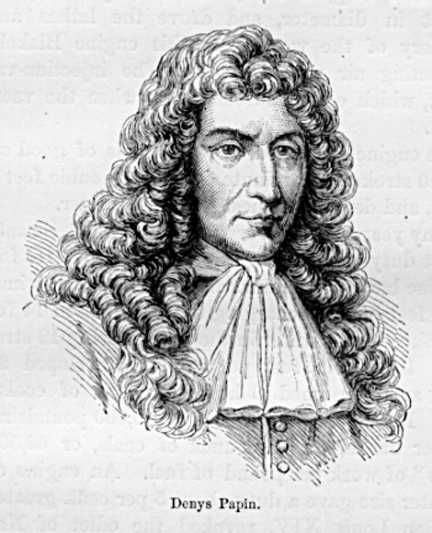
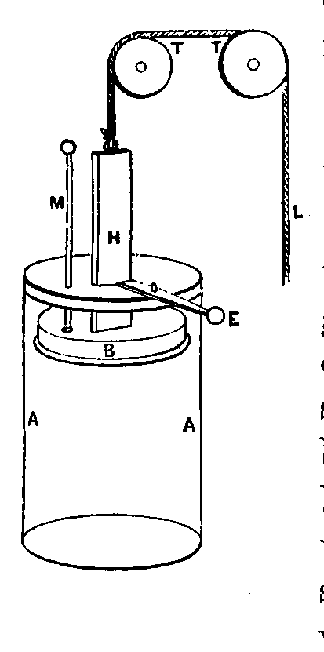 Dennis Papin
(1647-1712?) of France, distinguished as a doctor and scientist, produced in
1690 the first steam engine with a piston, and the first piston engine in which
condensation was used to produce a vacuum.
He is also credited with the
invention of the safety valve, which proved more lasting than his engine design,
which used external air pressure to move the piston, rather than high pressure
steam. His engine design was more akin to that of a pressure cooker. Fortunately
for French cuisine, he did not address this application.
Dennis Papin
(1647-1712?) of France, distinguished as a doctor and scientist, produced in
1690 the first steam engine with a piston, and the first piston engine in which
condensation was used to produce a vacuum.
He is also credited with the
invention of the safety valve, which proved more lasting than his engine design,
which used external air pressure to move the piston, rather than high pressure
steam. His engine design was more akin to that of a pressure cooker. Fortunately
for French cuisine, he did not address this application.
Thomas Newcomen's Engine
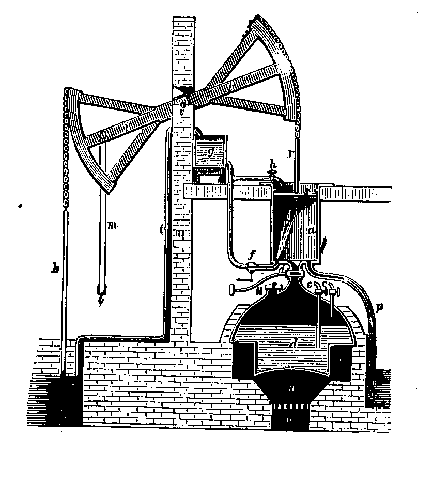 In 1712, Thomas Newcomen (1663-1729), a blacksmith from Dartmouth,
England, produced a machine which was unmistakably a true steam engine. Called
an atmospheric engine, it featured a piston that was driven down by the pressure
of the atmosphere, a partial vacuum having been previously formed within the
cylinder. Newcomen's engines made it possible to open new coal mines that would
have otherwise been unworkable. The Newcomen engine is apparently the first design
to make use of the "walking beam" pivoted arm to transfer power to the driven
device.
In 1712, Thomas Newcomen (1663-1729), a blacksmith from Dartmouth,
England, produced a machine which was unmistakably a true steam engine. Called
an atmospheric engine, it featured a piston that was driven down by the pressure
of the atmosphere, a partial vacuum having been previously formed within the
cylinder. Newcomen's engines made it possible to open new coal mines that would
have otherwise been unworkable. The Newcomen engine is apparently the first design
to make use of the "walking beam" pivoted arm to transfer power to the driven
device.
John Smeaton's Faster Engine
John Smeaton, a prominent English engineer (he coined the
term, "civil engineer"), figured out how to increase piston speed, improving
efficiency. In 1773, his engines replaced two windmills in a drydock at
the shipyards of Peter the Great in Constadt. (Kronstadt?) The drydock could
accommodate up to ten ships, and had been imperfectly drained by the
windmills, which took over a year to empty the dock.
James Watt: The Critical Improvements
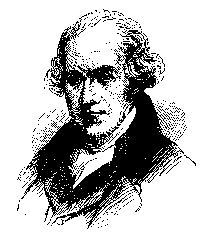 Known as the father of the steam engine, James Watt (1736-1819) was
born in Scotland, but did most of his work in England. (Perhaps he is the the
model Scots engineer from which Star Trek's Scotty was drawn.) While repairing
a model of the Newcomen engine, he conceived the idea of separating the condenser from the
cylinder, resulting in a substantial efficiency improvement. His 1769
patent also covered other improvements, such as steam jacketing, oil
lubrication, and insulation of the cylinder in order to maintain the
high temperatures necessary for maximum efficiency.
Known as the father of the steam engine, James Watt (1736-1819) was
born in Scotland, but did most of his work in England. (Perhaps he is the the
model Scots engineer from which Star Trek's Scotty was drawn.) While repairing
a model of the Newcomen engine, he conceived the idea of separating the condenser from the
cylinder, resulting in a substantial efficiency improvement. His 1769
patent also covered other improvements, such as steam jacketing, oil
lubrication, and insulation of the cylinder in order to maintain the
high temperatures necessary for maximum efficiency.
Richard Trevithick's Locomotive
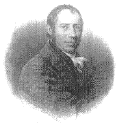 As England turned from being a country that relied on trade and agriculture
for its livelihood into one that based its living on the manufacture of goods,
it needed a way to deliver materials and products quickly. Richard Trevithick
(1771-1833), a British mining engineer, realized that the best way to harness
the power of existing steam engines was a a locomotive. In 1801, he built the
world's first practical steam locomotive, a steam propelled vehicle to carry
passengers on a Cornwall road.
Two years later, he built a locomotive that was able to haul wagons carrying
up to 15 tons of iron.
As England turned from being a country that relied on trade and agriculture
for its livelihood into one that based its living on the manufacture of goods,
it needed a way to deliver materials and products quickly. Richard Trevithick
(1771-1833), a British mining engineer, realized that the best way to harness
the power of existing steam engines was a a locomotive. In 1801, he built the
world's first practical steam locomotive, a steam propelled vehicle to carry
passengers on a Cornwall road.
Two years later, he built a locomotive that was able to haul wagons carrying
up to 15 tons of iron.
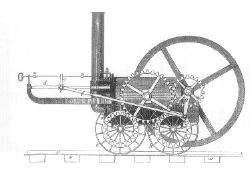 A one-cylinder locomotive with horizontal boiler,
horizontal piston and four driving wheels, it traveled nine miles in four hours
on smooth metal rails. Its success proved that sufficient traction could be
obtained without using gear wheels and and a cogged or toothed track.
Equally important, the Trevithick locomotive exhausted its steam into the
smoke box or flue of the engine's firebox. This method of exhaust provided a
forced draft for the firebox, creating a hotter fire, and was employed on all
subsequent steam locomotives. Trevithick also modified Watt's engine,
modifying it into a relatively small, high pressure design of considerably
reduced weight.
A one-cylinder locomotive with horizontal boiler,
horizontal piston and four driving wheels, it traveled nine miles in four hours
on smooth metal rails. Its success proved that sufficient traction could be
obtained without using gear wheels and and a cogged or toothed track.
Equally important, the Trevithick locomotive exhausted its steam into the
smoke box or flue of the engine's firebox. This method of exhaust provided a
forced draft for the firebox, creating a hotter fire, and was employed on all
subsequent steam locomotives. Trevithick also modified Watt's engine,
modifying it into a relatively small, high pressure design of considerably
reduced weight.
To show his improved locomotive to the worldly citizens of London, in
1808 Trevithick set up a circular track within an enclosure, charging admission
at five shillings per head. Although this amount was half of an average
weekly salary, people rushed to witness the machine's performance. The
"few who were not to timid" rode behind the chugging engine until a rail broke,
derailing the engine. Before this disaster, Trevithick had vainly offered
to race his engine with any racehorse for an uninterrupted 24 hours to see which
could cover the greater distance.
Peter Cooper's Legacy
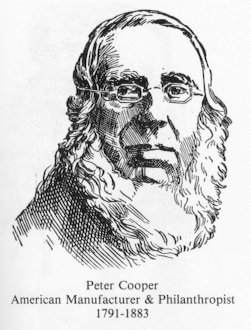 Peter Cooper (1791-1883) was a New York businessman who
left a remarkable legacy as an entrepreneur, inventor and philanthropist. The
son of a Revolutionary War officer, he was apprenticed to a coach maker when he
was 17. After several successful years, he left that trade and established
a series of businesses including cloth-shearing machines, an iron works, a glue
factory and an isinglass manufacturing plant. He not only invented America's
first steam locomotive, but also a washing machine, a compressed air engine for
ferry boats, a water powered device for moving canal boats, and numerous other
practical devices. His iron works rolled out the first iron structural
beams, and his unwavering support for Cyrus Field's Atlantic Cable helped make
that venture possible. He also served for a time as the President of the
American Telegraph Company.
Peter Cooper (1791-1883) was a New York businessman who
left a remarkable legacy as an entrepreneur, inventor and philanthropist. The
son of a Revolutionary War officer, he was apprenticed to a coach maker when he
was 17. After several successful years, he left that trade and established
a series of businesses including cloth-shearing machines, an iron works, a glue
factory and an isinglass manufacturing plant. He not only invented America's
first steam locomotive, but also a washing machine, a compressed air engine for
ferry boats, a water powered device for moving canal boats, and numerous other
practical devices. His iron works rolled out the first iron structural
beams, and his unwavering support for Cyrus Field's Atlantic Cable helped make
that venture possible. He also served for a time as the President of the
American Telegraph Company.
Though he had only one year of formal schooling, Cooper was a strong
advocate of a free public school system. In 1859, he founded Cooper Union
to offer free college courses in science, engineering and art. Classes are still
open to any student who can meet the intelligence and aptitude tests. He
summed up his own achievements by noting that "I have endeavored to remember
that the object in life is to do good."
By 1829, Cooper had constructed and tested his miniature rail locomotive,
the Tom Thumb. It was constructed using musket barrels for boiler tubes, but
managed the 13 mile stretch of B&O track between Baltimore and Ellicott's
Mills in good time, succeeding in reaching Cooper's objective of successfully
demonstrating the potential of the steam locomotive to railroad executives.
Three years later, the B&O rails stretched 137 miles north and west--the
longest reach of railroad track in the world.
The Giants of Steam
Three individuals and their early contributions deserve particular
recognition, as they laid the foundation for what came after.
Thomas Newcomen's Engine
Thomas Newcomen (1663-1729) of England, is credited with inventing the
first true steam engine. An iron master by occupation, he had an intimate
knowledge of the day-by-day pumping problems in tin mines. He spent at
least twelve years in experimentation before he built a full-scale steam engine.
Called an atmospheric engine, it was actually a pump. The engine consisted of a
brass cylinder open to the air. Steam was fed in under the piston from a
separate boiler and was condensed by a jet of cold water which was forced inside
the cylinder. A vacuum formed beneath the piston, allowing it to be driven down
by the pressure of the atmosphere acting on the top, so producing the power
stroke. The piston rod was connected by a chain to one end of awooden beam,
pivoted like a see-saw. The other end of the beam operated the piston of the
water pump in the mine shaft. The engine was capable of making about eight or
ten strokes a minute--that is, controlled automatically by its own valve gear.
Newcomen's engine depended upon the weight of the pump rods
to pull the steam piston up the cylinder. He did not make use of the expansion
of steam in his engine. Steam was employed merely to create the vacuum in the
cylinder, leaving the work to be done by atmospheric pressure. The first
recorded Newcomen engine was built in 1712 to drain a colliery (coal mine) at
Tipton, England. The engine was exported to North America about 1755. It
remained basically unchanged until James Watt's inventions and improvements in
1769. By 1790 the Newcomen engine had been almost completely replaced by the Watt
engine.
For all his success, Newcomen died in 1729 virtually unknown outside a
small circle of engineers. It is a measure of his importance, though, that
Britain's leading society for the study of the history of engineering and
technology, the Newcomen Society, was named after him when it was founded in 1921.
Dennis Papin's Engine
The first piston engine was developed in 1690 by the French
physician and inventor, Dennis Papin (1647-1712?), and was used
for pumping water. The actual work of the machine was
done by air rather than steam pressure. It consisted of a single cylinder that
also served as a boiler. A small amount of water was placed in the bottom of the
cylinder and heated until steam was formed. The pressure of this steam raised a
piston fitting in the cylinder, and after it was raised, the source of heat was
removed from the bottom of the cylinder. As the cylinder cooled, the steam
condensed and air pressure an the upper side of the piston forced the piston
down. Papin argued that his invention would have a distinct advantage over water
power. However, he found it difficult to raise financial support, and his career
ended in poverty and obscurity. Papin did not reach practical success in any of
his inveinventionst he paved the way for his
more successful followers.
James Watt's Improvements
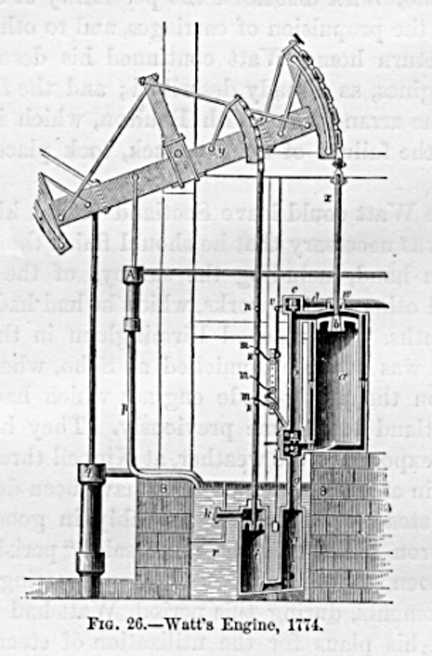 Scottish-born James Watt (1736-1819), although
he did not invent the steam engine, is revered as the father of the modem steam
engine, since his improved steam engines were powering factories, mills, and
pumps both In Europe and America by the end of the eighteenth century.
Watt worked as a mathematical-instrument maker from the age of 19., and soon
became interested in improving the steam engine. He made the steam engine a
practical machine, obtaining his first patent in 1769. Watt's first progress was
in insulating steam carrier pipes against loss of heat. and in protecting boiler
shells from rapid heat loss. This economy of heat was the base discovery which
did so much to establish Watt's preeminent position as a steam engineer. Watt
saw that it was absolutely essential that the cylinder should be kept as hot as
possible to prevent the undue loss of steam, and that all condensation must take
place in a vessel separate from the cylinder. This lead to his development of a
condenser external to the engine, which greatly improved engine economy and
efficiency. The separate condenser was the biggest single improvement ever made
to the steam engine. Watt determined the properties of steam, especially the
relation of its density to its temperature and pressure. His separate condensing
chamber prevented enormous losses of steam in the cylinder and enhanced the
vacuum conditions. Watt then achieved efficiency simply by covering the top of
the cylinder and using low-pressure steam rather than atmospheric pressure to
drive the piston down when a vacuum formed beneath it.
Scottish-born James Watt (1736-1819), although
he did not invent the steam engine, is revered as the father of the modem steam
engine, since his improved steam engines were powering factories, mills, and
pumps both In Europe and America by the end of the eighteenth century.
Watt worked as a mathematical-instrument maker from the age of 19., and soon
became interested in improving the steam engine. He made the steam engine a
practical machine, obtaining his first patent in 1769. Watt's first progress was
in insulating steam carrier pipes against loss of heat. and in protecting boiler
shells from rapid heat loss. This economy of heat was the base discovery which
did so much to establish Watt's preeminent position as a steam engineer. Watt
saw that it was absolutely essential that the cylinder should be kept as hot as
possible to prevent the undue loss of steam, and that all condensation must take
place in a vessel separate from the cylinder. This lead to his development of a
condenser external to the engine, which greatly improved engine economy and
efficiency. The separate condenser was the biggest single improvement ever made
to the steam engine. Watt determined the properties of steam, especially the
relation of its density to its temperature and pressure. His separate condensing
chamber prevented enormous losses of steam in the cylinder and enhanced the
vacuum conditions. Watt then achieved efficiency simply by covering the top of
the cylinder and using low-pressure steam rather than atmospheric pressure to
drive the piston down when a vacuum formed beneath it.
By 1781-82, Watt had made his
engine double-acting, as he had long wished to do. By applying steam
alternately below and above the piston to produce a power stroke in both
directions, he created an engine more suitable for providing rotating
motion. Three years later he patented "parallel motion", the invention of
which he was most proud, to keep a rigid piston rod moving vertically while
attached to the end of an oscillating beam. The rotative
engines were in great demand.
In 1781, Consolidated Mines of Cornwall replaced seven Newcomen engines
with five of Watt's. Performing the same work, they consumed only 6,100 tons of
coal a year to the Newcomen engines' 19,000 tons.
For inventive range and scientific skill, Watt was unrivaled. Not the
least of his innovations was the conception of horsepower.
Comparisons between steam-power and horse-power had been made by earlier
engineers, but Watt was one of the first to use a definite number: one
horse-power was measured precisely as 33.000 foot-pounds of work per minute.
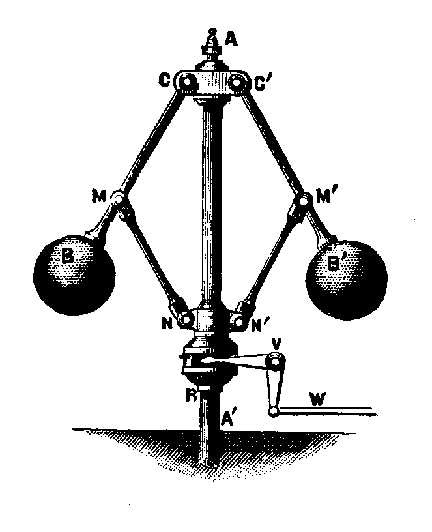 Within a few years, his products were frequently referred to as fourteen-horse
engines, twenty-horse engines, and so on.
The centrifugal or flyball governor,
which he invented in 1788, and which automatically controlled the speed of
an engine, is of particular interest today. This device foreshadowed twentieth-century
automation.
Within a few years, his products were frequently referred to as fourteen-horse
engines, twenty-horse engines, and so on.
The centrifugal or flyball governor,
which he invented in 1788, and which automatically controlled the speed of
an engine, is of particular interest today. This device foreshadowed twentieth-century
automation.
James Watt was also a renowned civil engineer, making
several surveys of canal routes. In 1767, he invented an attachment that adapted
telescopes for use in measurement of distances. Watt died In 1819 in
England, where he had done most of his work. An electrical unit, the
watt, was named in his honor.
Railroads
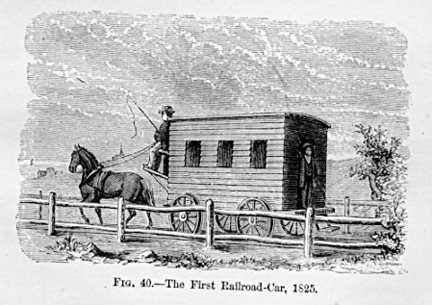 The single factor that made a successful railroad network
possible was the development of steam power during the eighteenth century
Industrial Revolution. Yet the "railroad concept" was much older than the
Industrial Revolution itself. As early as the beginning of the sixteenth
century, for example, German coal miners had found that it was easier to
move heavy loads of coal if the cart wheels ran on smooth tracks. The solution
was to lay wooden planks over the rough ground and push the carts along these
tracks. It was soon found that rails reduced friction and provided better
control of the moving vehicle. From here, it was a simple extension of the
concept to use horses or other animals to propel the cars along rails.
The single factor that made a successful railroad network
possible was the development of steam power during the eighteenth century
Industrial Revolution. Yet the "railroad concept" was much older than the
Industrial Revolution itself. As early as the beginning of the sixteenth
century, for example, German coal miners had found that it was easier to
move heavy loads of coal if the cart wheels ran on smooth tracks. The solution
was to lay wooden planks over the rough ground and push the carts along these
tracks. It was soon found that rails reduced friction and provided better
control of the moving vehicle. From here, it was a simple extension of the
concept to use horses or other animals to propel the cars along rails.
Early Railroads in Europe and America
There was immense hostility against the primitive railroad by
ironworkers, who feared the loss of their jobs if horses were replaced
by steam locomotives.
The coal industry in northeast England was more perceptive. In
1812, the Middleton Colliery Railroad started to use the world's first
commercial steam locomotive, designed by Matthew Murray, to move coal at mines.
From the very first, English designers built their
locomotives on a smooth cart-like rigid frame that passed outside the wheels and
dominated the design. American designers, with an inventive skill that
must have come from frontier training, put the frame inside the wheels, where it
was all but invisible. Eliminating the cart-like frame saved weight and
material, yielding a flexible machine that was far better adapted to the
uncertainties of early railroad track and to limited repair facilities.
One of the first trips by rail in
the United States was an 1831 run between Albany and Schenectady, New
York. Behind its wood-burning locomotive, the DeWitt Clinton, was a
flatcar for water and wood: behind that was a stagecoach-like section for
passengers. The train's initial starting jerk knocked most riders out of their
seats and sparks from the Clinton's smokestack set fire to the umbrellas they
had raised as shields. Many mechanical improvements were subsequently made, both
in England and in the United States.
One passenger described an 1830 locomotive ride as follows:
"Away we fly on the wings of the wind at the speed of fifteen to twenty-live
miles an hour, scattering sparks and flames on either side, passed over
three saltwater creeks, hop, step and jump and reached the end of the
line...before any of us had time to determine whether or not it was prudent to be scared."
Until about 1940,
steam engines provided the driving power of most locomotives used on U.S.
railroads. Subsequently, the steam locomotive largely became obsolete. In the
early 1980s, 12 steam Locomotives were operating on U.S. railroads, 10 of them
in use on narrow-gauge tourist routes in Colorado.
The Tom Thumb: An Influential Locomotive
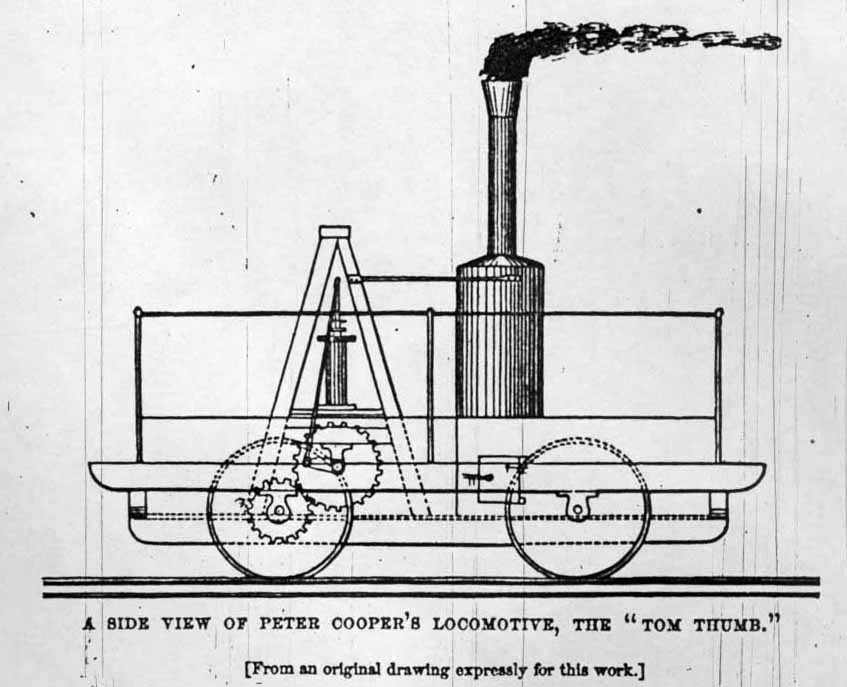 Tom Thumb was the most famous steam locomotive in early American railroad
history. It was built by Peter Cooper in 1829 to demonstrate to doubting railroad
executives that steam power would be more effective than the teams of horses
they were using.
Tom Thumb was the most famous steam locomotive in early American railroad
history. It was built by Peter Cooper in 1829 to demonstrate to doubting railroad
executives that steam power would be more effective than the teams of horses
they were using.
Rapid expansion of population had brought tremendous demand for faster
ways to transport goods and passengers. Canals were popular, but they took too
long to build and were limited to a few geographic areas. Wagons pulled by
horses along a system of rails could go wherever needed and seemed like a good
solution.
The problem was the limitations of the horses themselves-- it took such
large numbers of them, and they could only move so many miles an hour. In England,
railroad developers had already solved the problem by inventing a steam-powered
locomotive to move the loaded wagons. But the English locomotives, so successful
on the flat, straight English runs, were too heavy and rigid for the hills and
curves of American tracks.
Into this discouraging situation came a true pioneer of American
enterprise, Peter Cooper. A New York merchant, he gained an understanding
of mechanics from his experience as a carriage maker and iron foundry owner.
When the Baltimore and Ohio Railroad was organized In 1827. he made large
investments in Baltimore land.
The Baltimore and Ohio Railroad, the first in the country to provide
regular service, was launched to connect Baltimore with the Ohio River, 379
miles away. By 1829 only 13 miles of track were in service, and Cooper was
anxious about his investment. Convinced that steam power was the answer to the
railroad's problems, he urged the reluctant directors to try it. When they
hesitated, he assured them, "I believe I could knock together a locomotive
myself."
Cooper started with a small steam engine he had brought
from New York. The cyllnder was cylinder/4x 14 1/2 inches. He added
an upright boiler 20 inches in diameter and about 5 feet tall, and he used two
old musket barrels for pipes. To heat the coal hotter to make enough steam, he
rigged a blower to a drum. This was attached by a cord to the wheel of a railway
cart. The finished result was so tiny Cooper named it Tom Thumb.
It took several months of
tinkering to get things working right. On one early trial run the little
locomotive raced a horse-car on the adjacent track. lt was winning the
race when the cord to the blower's drum slipped off, and to the jeers
of the horse-car's drivers, the engine's steam drained away. Of course the horse
won the race.
At last Cooper was
ready to demonstrate his invention, and on Saturday, August 28, 1830, a crowd
gathered at Pratt Street depot in Baltimore to see them off. Tom Ihumb's
open-air carriage held two dozen dignitaries, and Cooper himself manned the
engine. Thirteen miles to the end of the line at Ellison's Mills, the little
locomotive carried the train up an average grade of 18 feet per mile and around
the sharp turns. It took an hour and 15 minutes. On the return trip, with
four more passengers, the train covered the 13 miles in 61 minutes, including a
four minute stop at the middle depot to take on water. The afternoon's
demonstration was a triumph. Cooper's experimental model had proved that for
railroads, steam power was the way to go. So Little Tom Thumb won the race after
all!
Locomotive Competitions
 Not until 1829 was a
locomotive developed in England for use in a regular commercial railway carrying
both passengers and freight. In that year George Stephenson entered his
locomotive, the Rocket, in competition with other locomotives for a prize of 500
pounds offered by the Liverpool and Manchester Railway. Stephenson's
locomotive best fulfilled all the conditions set by the railroad for practical
operation. The Rocket, weighing more than seven tons, pulled a load three times
its own weight at the rate of 12.5 mph and hauled a passenger coach filled with
passengers at 24 mph. This performance stimulated the building of other
locomotives and the extension of the railroad lines. It represented the first
breakthrough from a prolonged period of trial and error invention to establish
once and for all the potential efficiency of steam locomotion.
Not until 1829 was a
locomotive developed in England for use in a regular commercial railway carrying
both passengers and freight. In that year George Stephenson entered his
locomotive, the Rocket, in competition with other locomotives for a prize of 500
pounds offered by the Liverpool and Manchester Railway. Stephenson's
locomotive best fulfilled all the conditions set by the railroad for practical
operation. The Rocket, weighing more than seven tons, pulled a load three times
its own weight at the rate of 12.5 mph and hauled a passenger coach filled with
passengers at 24 mph. This performance stimulated the building of other
locomotives and the extension of the railroad lines. It represented the first
breakthrough from a prolonged period of trial and error invention to establish
once and for all the potential efficiency of steam locomotion.
Challenged by the vast sweep of continent that beckoned endlessly
westward, Americans embraced railroads with a special fervor. As the Rocket was
being developed in England, we were brashly beginning to build the Baltimore and
Ohio right-of-way that would cover no less than 300 miles, from Baltimore across
the Allegheny wilderness to Wheeling, West Virginia.
The first American railroads were powered by horses. The B & O
rented its horses from stagecoach companies, and no horse was required
to pull cars (named wagons) more than six or seven miles. Work done by
horsepower cost the extreme sum of $33 a day, an amount that caused management
to envision complete replacement of horses by steam power.
The dream was soon realized. In 1830 the Tom Thumb made Its historical
journey to Elliott's Mills outside of Baltimore, averaging five and one-half
miles per hour. The following year, watchmaker Phineas Davis built the
York, an engine which was vastly superior to the Tom Thumb, and won the first
prize of $4,000 in a B & O contest for the best steam engine. The York
negotiated the sharpest curves at the maximum fifteen mph required and obtained
speed bursts of thirty-five mph on the straightaways. Further, the York
could be operated on $16 a day, less than half the cost of equivalent horse-based
propulsion.
After the successful use of steam by the B & O, rail
networks of the industrialized societies rapidly expanded, binding together the
industries and communities of the world. Locomotives expanded, too.
The far descendants of the little Tom Thumb evolved into giant articulated
monsters of the rails whose appearance and sounds will never be forgotten by
any who experienced them.
The most generally used classification of locomotives is based on the
number and arrangement of wheels with which the engine is equipped. This
classification gives the number of driving wheels, and the number of wheels on
the trailing truck. Thus, a 2-4-0 locomotive is one with a two-wheel leading
truck, four driving wheels, and no trailing truck. The typical locomotive
of the 1800s and 1870s was a 4-4-0 weighing about 30 tons. Pre WW II
locomotives included articulated 2-8-8-4 types capable of hauling 15,000 tons of
load on level ground. After the war, steam was displaced rapidly by Diesel
power due to its more economical operating costs.
Steam Automobiles and the Stanley Steamer
The Stanley Steamer, one of the most famous steam-powered automobiles,
was built and manufactured by identical twins, Francis Edgar and Freelan Oscar
Stanley, born into a large family on a farm in Kingfield, Maine. In the fall of
1896, the Stanley brothers began to make a steam horseless carriage for their
own use. Many people offered to buy it, even before the car was completed.
After selling the first model, they proceeded to build two more. These two cars
were also sold before completion in the spring of l897. During that year and
into 1898, they built and sold approximately 18 horseless carriages. Through
July of 1899, 200 cars were actually built and sold, making the Stanley brothers
the first men in the world to manufacture automobiles in commercial quantities.
In the spring of 1899, the Stanleys sold the company and their
manufacturing rights to Locomotive Company of America, but in the spring of 1901
the Stanleys bought back their manufacturing rights and formed Stanley Motor
Carriage Company.
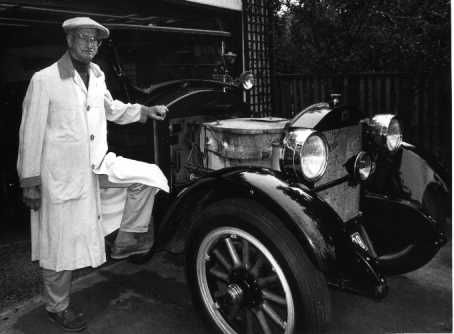 The car was composed of 32 moving parts, including the front and rear
wheels and steering gear. Kerosene was the main fuel at first, but gasoline
was eventually used in their fire-tube pot boiler.
The entire control of the Stanley Steamer was between two fingers of one
hand. It did not have a transmission, but it had a two-cylinder engine
located beneath the floor and just one gear engaged the center of its
crankshaft, which directly turned the rear wheels.
The car was composed of 32 moving parts, including the front and rear
wheels and steering gear. Kerosene was the main fuel at first, but gasoline
was eventually used in their fire-tube pot boiler.
The entire control of the Stanley Steamer was between two fingers of one
hand. It did not have a transmission, but it had a two-cylinder engine
located beneath the floor and just one gear engaged the center of its
crankshaft, which directly turned the rear wheels.
A distinguishing trademark was the car's rounded hood. It
operated smoothly, was almost impossible to stall and was quick to accelerate.
It was really a rolling stove--a kind of self-propelled furnace. Its disadvantages
included the several minutes it required to get steamed up. the limited
number of miles that could be traveled on one boiler full of water, the quick
corrosion of the boiler, and difficulties encountered with the burner.
Fred Mariott, who headed the
maintenance department of the Stanley factory, made history in 1906, when
he established the world's speed record of 127.66 miles per hour in the Stanley
Rocket at Ormond Beach, Florida. The record, which applies to cars having less
than 30 horsepower, still stands today. The Stanley Brothers' love for racing
ended the following year when a Stanley Steamer, unoficiallunofficiallyt 197
miles an hour, was involved in an accident that demolished the car. In 1907, a
Stanley Steamer became the first automobile to travel faster than a train.
This vehicle was clocked at 150 miles per hour.
In 1908, The Stanley
brothers produced and sold (for about $2,500) a "Gentleman's 30 Horsepower
Speedy Roadster" capable of 60 miles per hour that could run more than 50
miles on a single tank of water. These sporty racing cars were 13 feet long,
and most of them were driven into the ground by their enthusiastic operators.
Approximately 4,000 Stanley Steamers were sold in 1908, but
sales of steam cars declined as gasoline-powered automobiles became increasingly
popular. In 1917, the brothers retired and the company continued under new
management until it went bankrupt in 1924. Steam cars, like early electric cars,
could not compete with cars powered by the gasoline-fueled internal-combustion
engines. People were afraid to drive a vehicle that had an open flame and hot
steam. In the winter, huge clouds of white vapor were produced when the car was
running, and the water used to make the steam tended to freeze the car was
not in use. In addition, it took about fifteen minutes to get up steam, and
frequent stops were necessary to replace the water lost through
boiling.
Steam on Water
More than 70 per cent of the earth's surface is water, and this water
was often a great barrier to travel. The limitless distances of the seas and
oceans were a challenge to land bound civilizations. Early ships made use of
muscle, wind and currents for propulsion, eventually achieving very efficient
and practical designs. But it was steam power that actually began to make the
world smaller.
Pennsylvanian Robert Fulton (1765-1815), artist, gunsmith, and engineer, is most usually associated
with the invention of the steamboat. He had begun experimenting with paddle
wheel boats as a boy in 1779. He went to Europe to study painting, but soon
turned to engineering projects. In 1800, Fulton attempted to sell the French
government a submarine to sink British ships. In 1803 he produced a model ofa
side-wheel boat and soon afterwards a working vessel, which was first
successfully demonstrated on the Seine river in Paris, France. However,
Europe showed no interests in Fulton's inventions at that time and he returned to the United States to
continue his experiments.
In 1807 Fulton employed a 20-horsepower James Watt-type
engine driving a paddlewheel crankshaft in his now famous steamboat, the
Clermont. This boat operated pleasure trips on the Hudson River between New York
and Albany. It was a flat-bottomed. 100-ton ship with a hull that could carry
both passengers and freight. A contemporary called her "a monster moving on the
waters, defying wind and tide,and breathing flames and smoke." Burning pine wood
for fuel instead of coal, the ship moved faster than any steamboat before,
attaining a speed of five miles an hour.
The Clermont traveled 130 miles on its
first voyage. Within three months, it had earned $1,000 against the initial cost of $20,000.
The first steamer to make a sea voyage was Colonel John Stevens's Phoenix, which in 1809
steamed from Hoboken to Philadelphia, and very soon people on both sides
of the Atlantic were dreaming of crossing it by steam. The Americans won the
race when in 1819 the steamer Savannah from Georgia traveled to St. Petersburg
via Great Britain and the Northern European ports. It was a trying trip: all the
coal on board had been consumed before the Savannah reached Ireland, and the
return trip to the United States was carried out under sail alone.
A British ship, the Sirius, in
1838 became the first vessel to complete a transatlantic
voyage entirely by steam. The Sirius was also one of the first steamships
to be fitted with a surface condenser that allowed fresh water to be used and
re-used in the boilers in place of saltwater.
As early as 1811, the first steamboat on the Ohio River was
launched. The subsequent opening up of
the Western frontiers would have been impossible without steamboats, small, light, fast and
inexpensive. By 1830, some 230 steamers were churning America's rivers. Prior to
steam, 120 days were employed in poling flatboats from New Orleans to St. Louis,
a journey of 1,300 miles. By 1826, steamboats had reduced passage time to
nine and a half days. By 1834, the number of steamboat arrivals in New Orleans annually was 2,300, indicative of
that port's trade.
The zenith of life on the Mississippi River, 2,350 miles
long, came with the steamboat, but rivers farther west were also transformed
when the steamboat arrived. Thus, along the distant Colorado River, large
numbers of paddle wheel steamboats provided the cheapest and most efficient form
of transport in the West for more than fifty years after
the California gold rush of 1849.
Women and Steam Locomotives
The outbreak of war In Europe in
1914 set the stage for a new relationship between women and the American
railroads. After attacks on American citizens in 1917, the nation declared war
against Germany and its allies. The war required the mobilization of millions of
American men, creating a major shortage of labor needed to cope with the heavy
increase in military traffic. The railroads were forced to recruit employees on a
large scale for the first time in their history. The major
percentage of jobs for women were clerical and cleaning positions. However,
it was not uncommon to see women maintaining huge steam locomotives, doing
everything from repairs to refueling. By the end of the war in 1918, railroads
employed 101,785 women in 99 different occupations.
When WW II broke out, many of the women still working after
the previous war were ready to retire, but stayed on to train the next group of
incoming railroad women. By war's end, 200.000 women had answered the call once again.
Most articles or
books written about women's work history usually point to the two world wars as
the period when railroads employed women for the first time in "men's jobs".
However, recent research has uncovered information that steam railroads, as
early as 1900, hired women as steam hammer operators, firemen and engineers,
baggage men, brakemen, laborers, and conductors, albeit in small numbers.
Exhibit Guide
Steam powered bicycle:
This one-horsepower steam bicycle
was available as a kit until the mid-1950s. Properly assembled, it could reach a
speed of 25 miles per hour. A flash boiler, which converts water to steam
instantly, provided energy without creating the safety hazard of a large pressurized
steam vessel.
The Corliss engine:
Named after its inventor, the
Corliss engine was claimed to be so efficient that Corliss allowed his customers
to pay him using the fuel savings realized from the use of his
design.
Hoist engine

| This model hoist engine portrays the type of steam engine frequently
used by miners to move men and equipment between the surface and underground
levels. Engines of this type might also have been used in industrial settings
to operate elevators. The model is 22 inches high, 9 inches wide and 15
inches long. |
Large Overtype stationary steam engine
|
Modelled after a typical single-cylinder steam engine that would have been used to power
all of the machinery in a small factory in the early part of the 20th century. A typical
application would be in a textile mill for operating large weaving looms and other
equipment.
The model is powered by a small electric motor connected to the large fly wheel through a
double reduction belt drive.
| 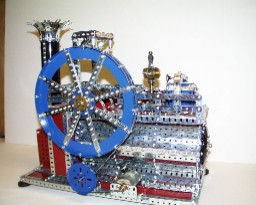 |
Showman's steam tractor:
| Modelled after a large steam-powered tractor that would have been used at a county fair in the 1920s. This machine would be used to tow wagons to transport the equipment, to power machinery, and to supply electricity to light up the fair and power the rides. Also known as a road locomotive, it would have a differential for operation on paved roads.
The model - at 19" long - is approx. 1/13 full size. The canopy is fully lighted and the
model is powered by a small electric motor hidden in the coal bunker. A working
differential is installed, as well as a winding drum for use with a crane.
Media: Mostly Meccano construction set parts made in Liverpool, England from WWII through
the 1970s. Meccano was the English counterpart to the American Erector Set. These two
models were built from a large collection of parts obtained over many years, rather than
from a single construction set.
|
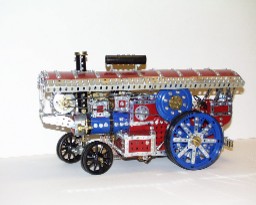 |
Walking arm pump:
The reciprocating motion of the movable beam used to transfer power from the steam
engine to the powered device reminded people of the motion of walking legs,
hence the name. Walking beams were in use on the ferries that traveled San
Francisco Bay into the 1950s, and can be seen today on the frequently
encountered oil pumps scattered across the American landscape -- although these are driven by
Diesel engines.
Model steam locomotives:
A variety of models are
on exhibit, some large enough to actually ride. Some of these have been
used as props in local theatre productions. The models
include:
"Smokey" 4-4-0
The 4-4-0 designation refers to
the wheel arrangement: 4 wheels on the leading truck, 4 drivers, and no trailing
truck. The 4-4-0 was in common use throughout the 19th century. The
decoration is typical for the Civil War period. Note the mountain scene painted
on the side of the headlight. Engines of the period were often assigned to
a particular engineer, who took great pride in the appearance and maintenance of
his mechanical steed and added gold leaf, custom whistles and other decorative
items.
Tom Thumb 2-2-0
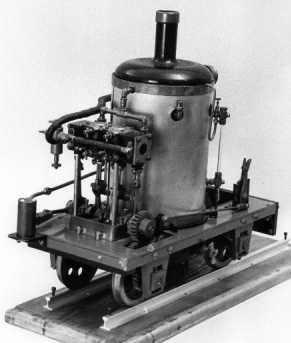 Tom Thumb was the first American-built locomotive to be used in public commercial
service. Designed and constructed by Peter Cooper in 1829, it figured in a
famous race against a horse, staged to persuade the new B&O Railroad to
purchase the locomotive. The horse won, although Tom Thumb led until a
drive belt began slipping. The locomotive was disassembled and recycled for
parts in 1834, but a full sized operating replica is on display in Baltimore.
Tom Thumb was the first American-built locomotive to be used in public commercial
service. Designed and constructed by Peter Cooper in 1829, it figured in a
famous race against a horse, staged to persuade the new B&O Railroad to
purchase the locomotive. The horse won, although Tom Thumb led until a
drive belt began slipping. The locomotive was disassembled and recycled for
parts in 1834, but a full sized operating replica is on display in Baltimore.
Consolidation 2-8-0
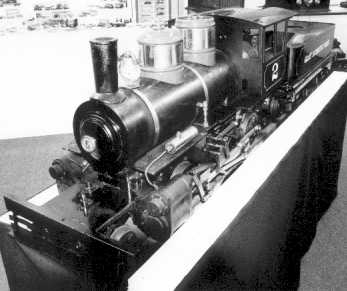 The Consolidation was one of the most popular types of locomotive in
use around the turn of the century. This locomotive is modeled after one in
used by the Denver and South Park Railroad in the 1880s. The original was
actually a narrow gauge locomotive, operating on rails only 3 feet apart, but
this model reflects standard gauge dimensions. It also displays the more modern
valve gear in use after 1910. This operating model is 75 inches long,
16 inches high and about 15 inches wide.
The Consolidation was one of the most popular types of locomotive in
use around the turn of the century. This locomotive is modeled after one in
used by the Denver and South Park Railroad in the 1880s. The original was
actually a narrow gauge locomotive, operating on rails only 3 feet apart, but
this model reflects standard gauge dimensions. It also displays the more modern
valve gear in use after 1910. This operating model is 75 inches long,
16 inches high and about 15 inches wide.
Shay locomotive:
The Shay locomotive,
designed by logger Epraim Shay in 1880, was frequently used on narrow gauge
logging railroads, where its small size, rotating trucks and its high gearing
ratio made it ideal for hauling logs over steep grades and around sharp curves
from cutting site to saw mill . Power was delivered through crankshafts to
a pair of independently swiveling powered trucks. Over 2700 Shays were built,
but fewer than 100 remain. Locomotives of this type are still in use, but now
serve to haul tourists, rather than logs.
It's distinctive rapid huffing and puffing is often described by railroaders
as "Going six and sounding like sixty".
Did you enjoy this exhibit? Your on-line donation will help us maintain this exhibit and create others. Thanks for your support!
Bibliography
Web Sites
California State Railroad Museum (Sacramento)
The California State Railroad Museum, part of the California Department of Parks and
Recreation, exists to preserve the history and artifacts of the railroad industry.
This site serves as an introduction to the Museum and many of its permanent exhibits.
Engineeringdegree.net
This is a good collection of links about the development of steam power.
Baltimore & Ohio Railroad Museum
The B&O Railroad Museum possesses one of the oldest and most comprehensive railroad
collections in the world. Its roster of rolling stock, historic buildings, and
assortment of small artifacts make it a mecca of railroadiana. From artwork and
silver to oil cans and shop tools the collection covers every aspect of an industry
interwoven into the folkore and culture of America.
History Of Trains
Totally dedicated to the trains from 1800 to 1950's
History of Steam Power
Features some very cool exhibits -- a collection of beautifully crafted
electrically-operated scale models and actual steam engines of all types.
Books
Aboard a Steam Locomotive, A
Sketchbook, Huch Scarry, Prentice Hall.
New York, 1987
Amazing Boats, Eyewitness Juniors-2l. Alfred Knopf. New York
Colonial Craftsmen
and the Beginning of the American Industry,
written and illustrated by Edwin
Tunis. The World Publishing Company.
Cleveland and New York,
1965.
Early American Steam Locomotives, First Seven
Decades--1830-1900.
Reed Kinert, Superior Publishing Co., Seattle,
1962.
Eighteenth Cenhuy Inventlons, K.T. Rowland, David and
Charles,
Newton Abbot, Barnes and Noble Books, New York, 1974.
Guide to N.A. Steam Locomotives-History and Development
of Steam Power Since 1900.
George Drury, Kalmbach Books, WI.,1993.
A History of Technology,
the Industrial Revolution ,1750-1850,
Edited by Charles Singer, E.J.
Holmyard, K.R. Hall, Trevor I. Williams,
Vol. IV, Oxford at the Clarendon
Press, London, 1958.
How Things Work, Steve Parker, Random House, New
York, 1991
(for children)
The Industrial Revolution: Ideas That
Changed the World
Philip Wilkinson and Michael Pollard. Illustrated by Robert
Ingpen. Chelsea
House Publishers, NewYork and Phlldadephla,
1995.
Machines,
Life Science Library. Robert O'Brlen, and the editors
of Life, Time Incorporated,
New York, 1964.
The Marshall Cavendish
Illustrated Guide to Steam Locomotives,
Christopher Chant, illustrated by
John Batchelor, Marshall Cavendish.
New York. London. Toronto, Sydney.
1989 (for children)
The Power of Steam: An Illustrated History of
the World's Steam Age,
Asa Briggs, The University of Chicago Press,
1982,
Ships of Steam, Lamont Buchanan, McGraw-Hill,
1956.
The Stationary Steam Engine, George Watkins, David and
Charles,
Newton Abbot, W. J. Holman Limited, 1968.
Steamboat Days,
Fred Erving Dayton, Illustrated by John Wolcott
Adams, Frederick Stokes Co.,
New York, 1925.
The Steam Engine, Its Form and Function W. A. Tuplin,
Scribner.
New York, 1974.
The Story of the Stanley Steamer,
George Woodbury, Norton and Company, NewYork, 1950.
Technics and
Civilization, Louis Mumford, A Harbinger Book,
Harcourt. Brace, and World.
Inc., New York and Burlingame, 1934,
1962.
The Technolgy of Man. A
Visual History, Carlo Cipolla and Derek
Birdsall.,Holt. Rinehart, and
Winston, New York, 1980.
This Is the Way it Works-A Collection of
Machines, Robert Gardner.
Illustrated by Jeffrey Brown, Doubleday and
Company, Garden City.
New York, 1980.
Trains Around the World, Octopus Books, London, 1972
Our Special Thanks
The Museum is indebted to many
individuals for this exhibit. We commend and thank in particular:
Dick Bartell, Bill Baumbach, Jim
Bove, Shirley Burman, Ann Chaimberlain, Glen Cristofferson, John Grant, Don
Kepfer, Frank Livermore, Peggy Morris, Andrew Morrison, Paul Nyberg, Dave
Peterson, Monroe Postman, and Evelyn White for loaning the artifacts and
materials displayed in this exhibit.
Thanks also to Art Adams, Sue Beaver, Roger Broussal, Dick
Clark, Ernie Faxon, Charles Gillis, Ralph Igler, Wayland Lee, Gen Leninger,
Beverly Nelson, Theodora Nelson, Charlie Pack, Bill Wehrend, Miriam Wehrend,
Robert Wersted, Ann Wright and Gordon Wright
for planning, installing, and supporting this exhibit.
 In 1712, Thomas Newcomen (1663-1729), a blacksmith from Dartmouth,
England, produced a machine which was unmistakably a true steam engine. Called
an atmospheric engine, it featured a piston that was driven down by the pressure
of the atmosphere, a partial vacuum having been previously formed within the
cylinder. Newcomen's engines made it possible to open new coal mines that would
have otherwise been unworkable. The Newcomen engine is apparently the first design
to make use of the "walking beam" pivoted arm to transfer power to the driven
device.
In 1712, Thomas Newcomen (1663-1729), a blacksmith from Dartmouth,
England, produced a machine which was unmistakably a true steam engine. Called
an atmospheric engine, it featured a piston that was driven down by the pressure
of the atmosphere, a partial vacuum having been previously formed within the
cylinder. Newcomen's engines made it possible to open new coal mines that would
have otherwise been unworkable. The Newcomen engine is apparently the first design
to make use of the "walking beam" pivoted arm to transfer power to the driven
device.
 About 2,000 years ago, Greek mathematician Hero
experimented with steam power, constructing a rudimentary rotary steam engine. A
spinning ball driven by steam jets, he considered the device a toy. More than 1600 years later, two
British inventors began to turn steam power into practical devices -- Thomas
Savery in 1698 and Thomas Newcomen in 1705. James Watt further improved on
their inventions, patenting several designs that earned him the title of father
of the modern steam engine.
About 2,000 years ago, Greek mathematician Hero
experimented with steam power, constructing a rudimentary rotary steam engine. A
spinning ball driven by steam jets, he considered the device a toy. More than 1600 years later, two
British inventors began to turn steam power into practical devices -- Thomas
Savery in 1698 and Thomas Newcomen in 1705. James Watt further improved on
their inventions, patenting several designs that earned him the title of father
of the modern steam engine.
 Hero was not the only ancient
familiar with the concept of steam power. Records of a simple hot air engine,
designed to open and close temple doors, are among records from ancient Egypt dating to
280 B.C.
Hero was not the only ancient
familiar with the concept of steam power. Records of a simple hot air engine,
designed to open and close temple doors, are among records from ancient Egypt dating to
280 B.C.
 Edward Somerset, second Marquis of Worcester, England, is
credited with being the first operating steam engine builder. In 1663, he
invented an apparatus for raising water by steam power, and it was actually used
for this purpose at Vauxhall, near London.
Edward Somerset, second Marquis of Worcester, England, is
credited with being the first operating steam engine builder. In 1663, he
invented an apparatus for raising water by steam power, and it was actually used
for this purpose at Vauxhall, near London.
 In 1698 Captain Thomas Savery
(1650-1715), also of England, became the first person to produce and sell a
workable steam pump for raising water. It was crude, relying on hand
operated steam and water valves. Because the maximum suction lift of the pump
was only 25 feet, the receiver and furnace had to be located
underground.
In 1698 Captain Thomas Savery
(1650-1715), also of England, became the first person to produce and sell a
workable steam pump for raising water. It was crude, relying on hand
operated steam and water valves. Because the maximum suction lift of the pump
was only 25 feet, the receiver and furnace had to be located
underground.

 Dennis Papin
(1647-1712?) of France, distinguished as a doctor and scientist, produced in
1690 the first steam engine with a piston, and the first piston engine in which
condensation was used to produce a vacuum.
He is also credited with the
invention of the safety valve, which proved more lasting than his engine design,
which used external air pressure to move the piston, rather than high pressure
steam. His engine design was more akin to that of a pressure cooker. Fortunately
for French cuisine, he did not address this application.
Dennis Papin
(1647-1712?) of France, distinguished as a doctor and scientist, produced in
1690 the first steam engine with a piston, and the first piston engine in which
condensation was used to produce a vacuum.
He is also credited with the
invention of the safety valve, which proved more lasting than his engine design,
which used external air pressure to move the piston, rather than high pressure
steam. His engine design was more akin to that of a pressure cooker. Fortunately
for French cuisine, he did not address this application.
 Known as the father of the steam engine, James Watt (1736-1819) was
born in Scotland, but did most of his work in England. (Perhaps he is the the
model Scots engineer from which Star Trek's Scotty was drawn.) While repairing
a model of the Newcomen engine, he conceived the idea of separating the condenser from the
cylinder, resulting in a substantial efficiency improvement. His 1769
patent also covered other improvements, such as steam jacketing, oil
lubrication, and insulation of the cylinder in order to maintain the
high temperatures necessary for maximum efficiency.
Known as the father of the steam engine, James Watt (1736-1819) was
born in Scotland, but did most of his work in England. (Perhaps he is the the
model Scots engineer from which Star Trek's Scotty was drawn.) While repairing
a model of the Newcomen engine, he conceived the idea of separating the condenser from the
cylinder, resulting in a substantial efficiency improvement. His 1769
patent also covered other improvements, such as steam jacketing, oil
lubrication, and insulation of the cylinder in order to maintain the
high temperatures necessary for maximum efficiency.
 As England turned from being a country that relied on trade and agriculture
for its livelihood into one that based its living on the manufacture of goods,
it needed a way to deliver materials and products quickly. Richard Trevithick
(1771-1833), a British mining engineer, realized that the best way to harness
the power of existing steam engines was a a locomotive. In 1801, he built the
world's first practical steam locomotive, a steam propelled vehicle to carry
passengers on a Cornwall road.
Two years later, he built a locomotive that was able to haul wagons carrying
up to 15 tons of iron.
As England turned from being a country that relied on trade and agriculture
for its livelihood into one that based its living on the manufacture of goods,
it needed a way to deliver materials and products quickly. Richard Trevithick
(1771-1833), a British mining engineer, realized that the best way to harness
the power of existing steam engines was a a locomotive. In 1801, he built the
world's first practical steam locomotive, a steam propelled vehicle to carry
passengers on a Cornwall road.
Two years later, he built a locomotive that was able to haul wagons carrying
up to 15 tons of iron.
 A one-cylinder locomotive with horizontal boiler,
horizontal piston and four driving wheels, it traveled nine miles in four hours
on smooth metal rails. Its success proved that sufficient traction could be
obtained without using gear wheels and and a cogged or toothed track.
Equally important, the Trevithick locomotive exhausted its steam into the
smoke box or flue of the engine's firebox. This method of exhaust provided a
forced draft for the firebox, creating a hotter fire, and was employed on all
subsequent steam locomotives. Trevithick also modified Watt's engine,
modifying it into a relatively small, high pressure design of considerably
reduced weight.
A one-cylinder locomotive with horizontal boiler,
horizontal piston and four driving wheels, it traveled nine miles in four hours
on smooth metal rails. Its success proved that sufficient traction could be
obtained without using gear wheels and and a cogged or toothed track.
Equally important, the Trevithick locomotive exhausted its steam into the
smoke box or flue of the engine's firebox. This method of exhaust provided a
forced draft for the firebox, creating a hotter fire, and was employed on all
subsequent steam locomotives. Trevithick also modified Watt's engine,
modifying it into a relatively small, high pressure design of considerably
reduced weight.
 Peter Cooper (1791-1883) was a New York businessman who
left a remarkable legacy as an entrepreneur, inventor and philanthropist. The
son of a Revolutionary War officer, he was apprenticed to a coach maker when he
was 17. After several successful years, he left that trade and established
a series of businesses including cloth-shearing machines, an iron works, a glue
factory and an isinglass manufacturing plant. He not only invented America's
first steam locomotive, but also a washing machine, a compressed air engine for
ferry boats, a water powered device for moving canal boats, and numerous other
practical devices. His iron works rolled out the first iron structural
beams, and his unwavering support for Cyrus Field's Atlantic Cable helped make
that venture possible. He also served for a time as the President of the
American Telegraph Company.
Peter Cooper (1791-1883) was a New York businessman who
left a remarkable legacy as an entrepreneur, inventor and philanthropist. The
son of a Revolutionary War officer, he was apprenticed to a coach maker when he
was 17. After several successful years, he left that trade and established
a series of businesses including cloth-shearing machines, an iron works, a glue
factory and an isinglass manufacturing plant. He not only invented America's
first steam locomotive, but also a washing machine, a compressed air engine for
ferry boats, a water powered device for moving canal boats, and numerous other
practical devices. His iron works rolled out the first iron structural
beams, and his unwavering support for Cyrus Field's Atlantic Cable helped make
that venture possible. He also served for a time as the President of the
American Telegraph Company.
 Scottish-born James Watt (1736-1819), although
he did not invent the steam engine, is revered as the father of the modem steam
engine, since his improved steam engines were powering factories, mills, and
pumps both In Europe and America by the end of the eighteenth century.
Watt worked as a mathematical-instrument maker from the age of 19., and soon
became interested in improving the steam engine. He made the steam engine a
practical machine, obtaining his first patent in 1769. Watt's first progress was
in insulating steam carrier pipes against loss of heat. and in protecting boiler
shells from rapid heat loss. This economy of heat was the base discovery which
did so much to establish Watt's preeminent position as a steam engineer. Watt
saw that it was absolutely essential that the cylinder should be kept as hot as
possible to prevent the undue loss of steam, and that all condensation must take
place in a vessel separate from the cylinder. This lead to his development of a
condenser external to the engine, which greatly improved engine economy and
efficiency. The separate condenser was the biggest single improvement ever made
to the steam engine. Watt determined the properties of steam, especially the
relation of its density to its temperature and pressure. His separate condensing
chamber prevented enormous losses of steam in the cylinder and enhanced the
vacuum conditions. Watt then achieved efficiency simply by covering the top of
the cylinder and using low-pressure steam rather than atmospheric pressure to
drive the piston down when a vacuum formed beneath it.
Scottish-born James Watt (1736-1819), although
he did not invent the steam engine, is revered as the father of the modem steam
engine, since his improved steam engines were powering factories, mills, and
pumps both In Europe and America by the end of the eighteenth century.
Watt worked as a mathematical-instrument maker from the age of 19., and soon
became interested in improving the steam engine. He made the steam engine a
practical machine, obtaining his first patent in 1769. Watt's first progress was
in insulating steam carrier pipes against loss of heat. and in protecting boiler
shells from rapid heat loss. This economy of heat was the base discovery which
did so much to establish Watt's preeminent position as a steam engineer. Watt
saw that it was absolutely essential that the cylinder should be kept as hot as
possible to prevent the undue loss of steam, and that all condensation must take
place in a vessel separate from the cylinder. This lead to his development of a
condenser external to the engine, which greatly improved engine economy and
efficiency. The separate condenser was the biggest single improvement ever made
to the steam engine. Watt determined the properties of steam, especially the
relation of its density to its temperature and pressure. His separate condensing
chamber prevented enormous losses of steam in the cylinder and enhanced the
vacuum conditions. Watt then achieved efficiency simply by covering the top of
the cylinder and using low-pressure steam rather than atmospheric pressure to
drive the piston down when a vacuum formed beneath it.
 Within a few years, his products were frequently referred to as fourteen-horse
engines, twenty-horse engines, and so on.
The centrifugal or flyball governor,
which he invented in 1788, and which automatically controlled the speed of
an engine, is of particular interest today. This device foreshadowed twentieth-century
automation.
Within a few years, his products were frequently referred to as fourteen-horse
engines, twenty-horse engines, and so on.
The centrifugal or flyball governor,
which he invented in 1788, and which automatically controlled the speed of
an engine, is of particular interest today. This device foreshadowed twentieth-century
automation. The single factor that made a successful railroad network
possible was the development of steam power during the eighteenth century
Industrial Revolution. Yet the "railroad concept" was much older than the
Industrial Revolution itself. As early as the beginning of the sixteenth
century, for example, German coal miners had found that it was easier to
move heavy loads of coal if the cart wheels ran on smooth tracks. The solution
was to lay wooden planks over the rough ground and push the carts along these
tracks. It was soon found that rails reduced friction and provided better
control of the moving vehicle. From here, it was a simple extension of the
concept to use horses or other animals to propel the cars along rails.
The single factor that made a successful railroad network
possible was the development of steam power during the eighteenth century
Industrial Revolution. Yet the "railroad concept" was much older than the
Industrial Revolution itself. As early as the beginning of the sixteenth
century, for example, German coal miners had found that it was easier to
move heavy loads of coal if the cart wheels ran on smooth tracks. The solution
was to lay wooden planks over the rough ground and push the carts along these
tracks. It was soon found that rails reduced friction and provided better
control of the moving vehicle. From here, it was a simple extension of the
concept to use horses or other animals to propel the cars along rails.
 Tom Thumb was the most famous steam locomotive in early American railroad
history. It was built by Peter Cooper in 1829 to demonstrate to doubting railroad
executives that steam power would be more effective than the teams of horses
they were using.
Tom Thumb was the most famous steam locomotive in early American railroad
history. It was built by Peter Cooper in 1829 to demonstrate to doubting railroad
executives that steam power would be more effective than the teams of horses
they were using.
 Not until 1829 was a
locomotive developed in England for use in a regular commercial railway carrying
both passengers and freight. In that year George Stephenson entered his
locomotive, the Rocket, in competition with other locomotives for a prize of 500
pounds offered by the Liverpool and Manchester Railway. Stephenson's
locomotive best fulfilled all the conditions set by the railroad for practical
operation. The Rocket, weighing more than seven tons, pulled a load three times
its own weight at the rate of 12.5 mph and hauled a passenger coach filled with
passengers at 24 mph. This performance stimulated the building of other
locomotives and the extension of the railroad lines. It represented the first
breakthrough from a prolonged period of trial and error invention to establish
once and for all the potential efficiency of steam locomotion.
Not until 1829 was a
locomotive developed in England for use in a regular commercial railway carrying
both passengers and freight. In that year George Stephenson entered his
locomotive, the Rocket, in competition with other locomotives for a prize of 500
pounds offered by the Liverpool and Manchester Railway. Stephenson's
locomotive best fulfilled all the conditions set by the railroad for practical
operation. The Rocket, weighing more than seven tons, pulled a load three times
its own weight at the rate of 12.5 mph and hauled a passenger coach filled with
passengers at 24 mph. This performance stimulated the building of other
locomotives and the extension of the railroad lines. It represented the first
breakthrough from a prolonged period of trial and error invention to establish
once and for all the potential efficiency of steam locomotion.
 The car was composed of 32 moving parts, including the front and rear
wheels and steering gear. Kerosene was the main fuel at first, but gasoline
was eventually used in their fire-tube pot boiler.
The entire control of the Stanley Steamer was between two fingers of one
hand. It did not have a transmission, but it had a two-cylinder engine
located beneath the floor and just one gear engaged the center of its
crankshaft, which directly turned the rear wheels.
The car was composed of 32 moving parts, including the front and rear
wheels and steering gear. Kerosene was the main fuel at first, but gasoline
was eventually used in their fire-tube pot boiler.
The entire control of the Stanley Steamer was between two fingers of one
hand. It did not have a transmission, but it had a two-cylinder engine
located beneath the floor and just one gear engaged the center of its
crankshaft, which directly turned the rear wheels.



 Tom Thumb was the first American-built locomotive to be used in public commercial
service. Designed and constructed by Peter Cooper in 1829, it figured in a
famous race against a horse, staged to persuade the new B&O Railroad to
purchase the locomotive. The horse won, although Tom Thumb led until a
drive belt began slipping. The locomotive was disassembled and recycled for
parts in 1834, but a full sized operating replica is on display in Baltimore.
Tom Thumb was the first American-built locomotive to be used in public commercial
service. Designed and constructed by Peter Cooper in 1829, it figured in a
famous race against a horse, staged to persuade the new B&O Railroad to
purchase the locomotive. The horse won, although Tom Thumb led until a
drive belt began slipping. The locomotive was disassembled and recycled for
parts in 1834, but a full sized operating replica is on display in Baltimore.
 The Consolidation was one of the most popular types of locomotive in
use around the turn of the century. This locomotive is modeled after one in
used by the Denver and South Park Railroad in the 1880s. The original was
actually a narrow gauge locomotive, operating on rails only 3 feet apart, but
this model reflects standard gauge dimensions. It also displays the more modern
valve gear in use after 1910. This operating model is 75 inches long,
16 inches high and about 15 inches wide.
The Consolidation was one of the most popular types of locomotive in
use around the turn of the century. This locomotive is modeled after one in
used by the Denver and South Park Railroad in the 1880s. The original was
actually a narrow gauge locomotive, operating on rails only 3 feet apart, but
this model reflects standard gauge dimensions. It also displays the more modern
valve gear in use after 1910. This operating model is 75 inches long,
16 inches high and about 15 inches wide.

